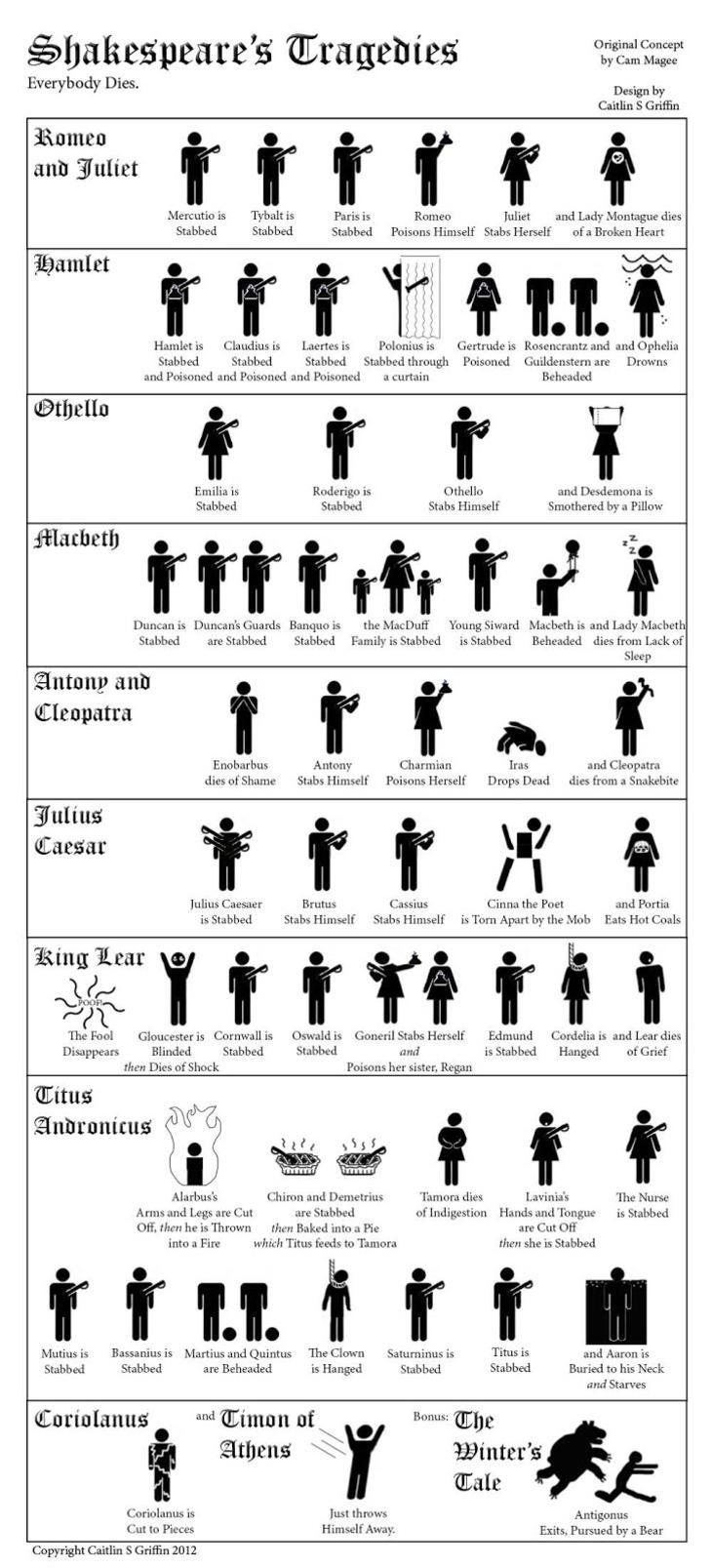| From: http://arts.uchicago.edu/event/midsummer-nights-dream |
Inspired by an outstanding production of Shakespeare's A Midsummer Nights Dream this past weekend (University of Ch
icago's Dean's Men Production), I thought I'd take post an interesting collection of facts, quotes and infographics related to Shakespeare and his works.
For me, the brilliance of Shakespeare's work is its timelessness, and his outstanding play with language. All gifts, thrills and treats, the infographics below cannot begin to relate or express. As a result, while fun, I find the infographic limiting. That said, they can be used to motivate, detail, and summarize aspects of The Bard's genius with language and character.
So, while I provide you with the inforgraphics below to help students and readers learn, appreciate, understand, and simply have fun with Shakespeare - it his insults, jabs, sonnets, and prose that should be savored and enjoyed. The infographics below introduce his work - be they his "history" plays, his tragedies, comedies, famous quotes, suggested reading, life history, or interesting statistics. They are fun but should be taken and enjoyed ALONG WITH THE reading and exploration of the texts and plays themselves.
More specifically, the infographics below relay:
- Aspects of his "History" plays;
- His tragedies - as told by their deaths;
- Interesting Shakespeare "statistics";
- His more famous quotes and where they're from;
- Goodreads.com helping you "Choose" which Shakespeare play you want to read; and
- An "anatomy" of Shakespeare's insults
- Slam, Shakespeare and Homer...
- Saluting Shakespeare: A Study Guide...
- Shakespeare and others on the No Nonsense of Nonsense...
- Shakespeare's Saucy Slams...
So please enjoy the infographics below, but don't stop here.
INFOGRAPHIC #1: The Hollow Crown: Shakespeare's History Plays - Shakespeare's Game of the Hollow Crown designed by Ricardo Galvez and Produced/Researched by Tom McNamara. Please visit Shakespeare Uncovered (http://www.pbs.org/wnet/shakespeare-uncovered/blog/anatomy-of-a-scene/)for more Shakespeare infographics. Note these come from PBS's Anatomy of a Scene: Shakespeare like your High School English teacher never taught you.
Hamlet and Macbeth are about a lot of things. Power and revenge. Madness and the otherworldly. But, when you get right down to it, these are plays about death and dying and murder: so that you know evil when it crosses your path.
See Shakespeare’s dark world illustrated and how each character came to their bloody end. (Click on the image to enlarge or open in new window.)
| http://www.pbs.org/wnet/shakespeare-uncovered/blog/anatomy-of-a-scene/ |
Richard II (Click on the image to enlarge or open in new window.)
Henry IV, Part 1 (Click on the image to enlarge or open in new window.)
| www.pbs.org/wnet/shakespeare-uncovered/blog/anatomy-of-a-scene/ |
Henry IV, Part 2 (Click on the image to enlarge or open in new window.)
Look at Shakespeare’s A Midsummer Night’s Dream and As You Like It. They take place in a wood and a forest respectively. Interestingly, “wood” meant “mad” back in Shakespeare’s day. So, it makes sense that while these are settings of enchantment and escape, they are also sites of confusion–even madness: where fairy queens fall in love with ass-headed (literally) common folk; or where you don’t even know if you’re sleeping or awake.
Enter Shakespeare’s Enchanted Forest and see all the comedy (or madness) that ensues. (Click on the image to enlarge or open in new window.)
| www.pbs.org/wnet/shakespeare-uncovered/blog/anatomy-of-a-scene/ |
INFOGRAPHIC #2: Shakespeare's Tragedies by Cam Magee and Caitlin Griffin - summarizing Shakespeare's tragedies in a nutshell. Cam Magee and Caitlin S. Griffin created a infographic that crosses Shakespeare with the people from bathroom signs. It shows every death from the tragedies, plus one of the most famous stage directions ever, from The Winter's Tale: "Exit, pursued by a bear."
 |
| http://io9.com/an-infographic-that-keeps-track-of-all-of-shakespeares-1534516437?utm_campaign=socialflow_io9_facebook&utm_source=io9_facebook&utm_medium=socialflo |
INFOGRAPHIC # 3 William Shakespeare in Statistics The source for this infographic was http://www.riokaelani.com which I found at View the full image at NoSweatShakespeare’s
Note that some of the personal 'items' below related to Shakespeare's personal life are believed true, but a good amount of his life was and still is not fully known to us.
| View the full image at NoSweatShakespeare’s Shakespeare facts & statistics infographic |
INFOGRAPHIC #4: Eight Phrases We Owe to William Shakespeare found at http://dailyinfographic.com/8-quotes-we-owe-to-william-shakespeare-infographic by Grammar.net 2011
| http://dailyinfographic.com/8-quotes-we-owe-to-william-shakespeare-infographic |
INFOGRAPHIC #5:What Shakespeare Play Should I read by Goodreads.com and posted by Jessica on 4/23/2013 at http://www.goodreads.com/blog/show/415-what-shakespeare-play-should-i-read-an-infographic
INFOGRAPHIC #6: A Grand Taxonomy of Shakespearean Insults created by Charley Chartwell at charleycharwell.com
| http://www.cooldailyinfographics.com/post/a-grand-taxonomy-of-shakespearean-insults |
That's about it for this week. Thank you for your visit. Please leave your own teaching ideas and/or your memories of the thrills and chills of reading/learning Shakespeare in the comments below.







